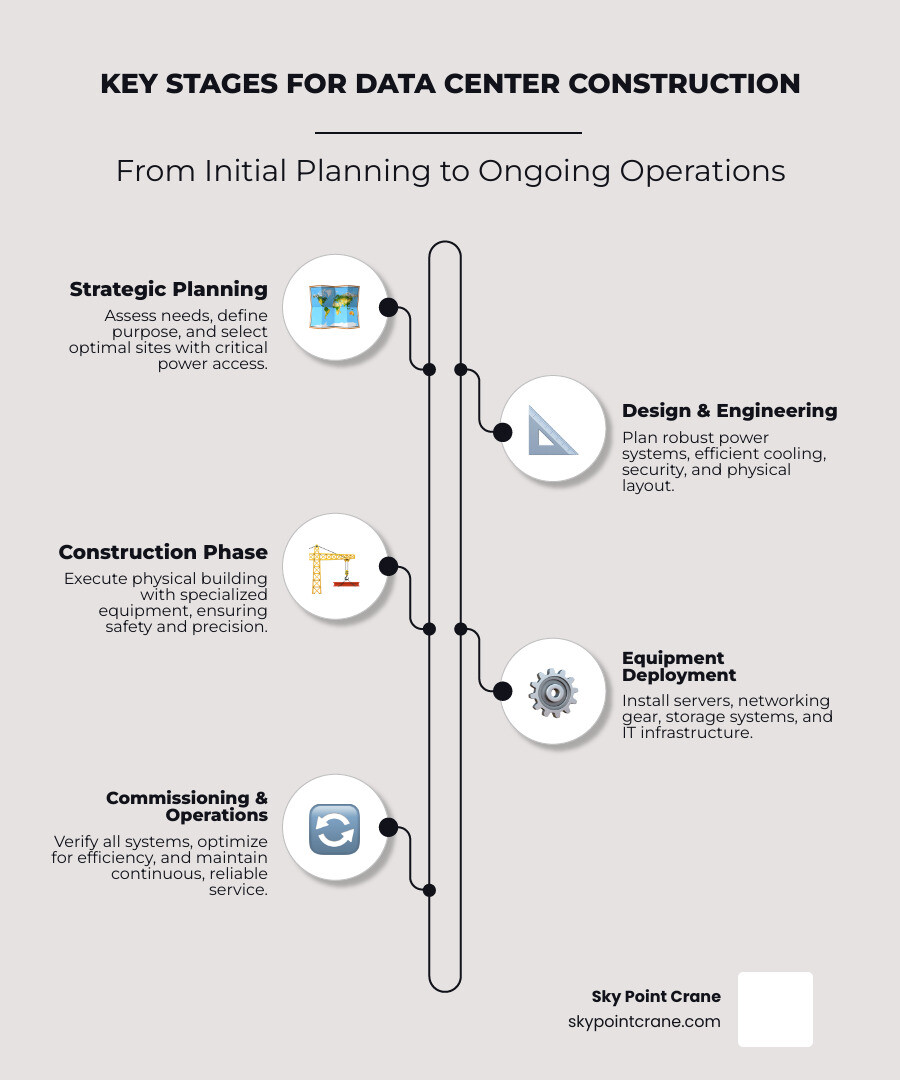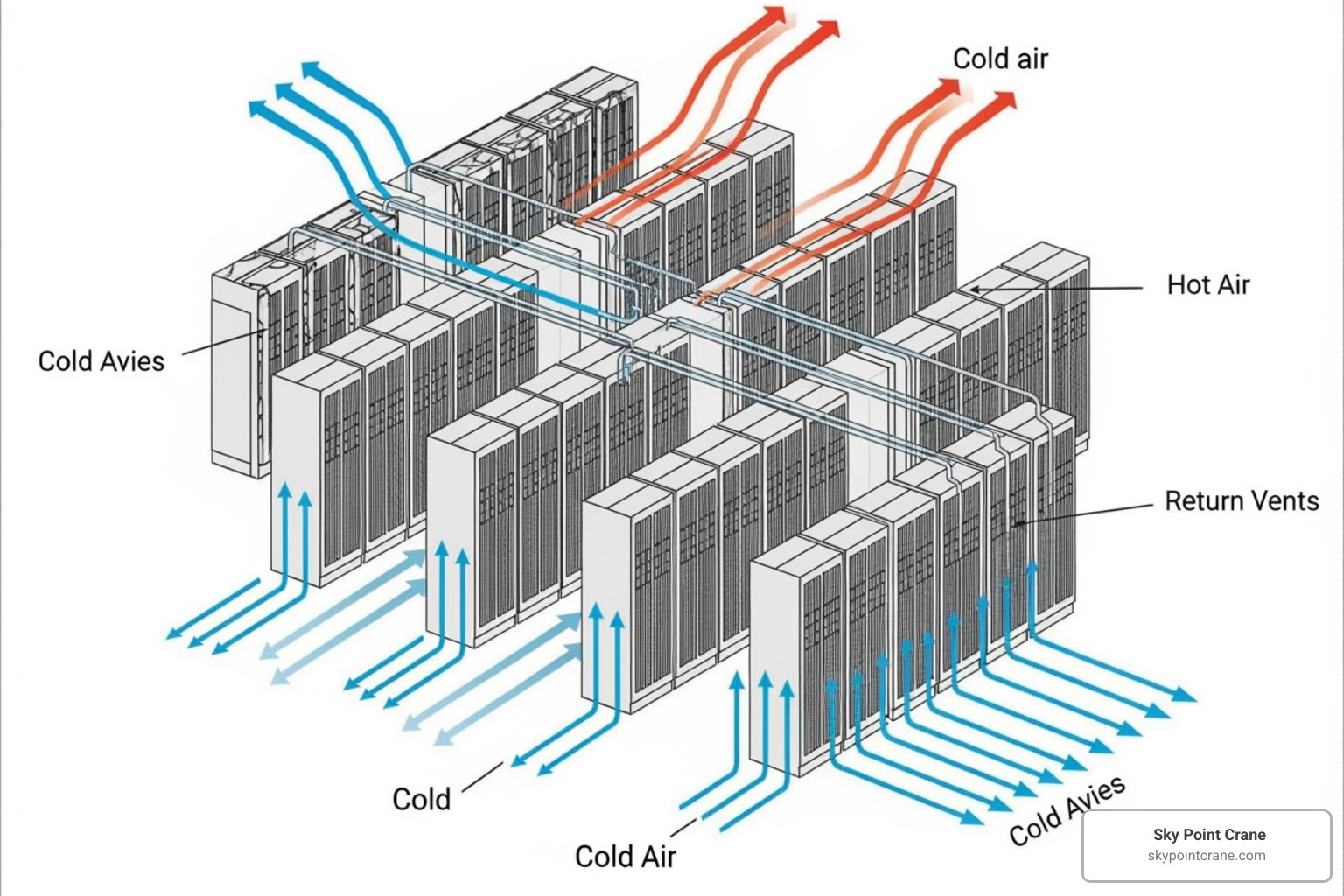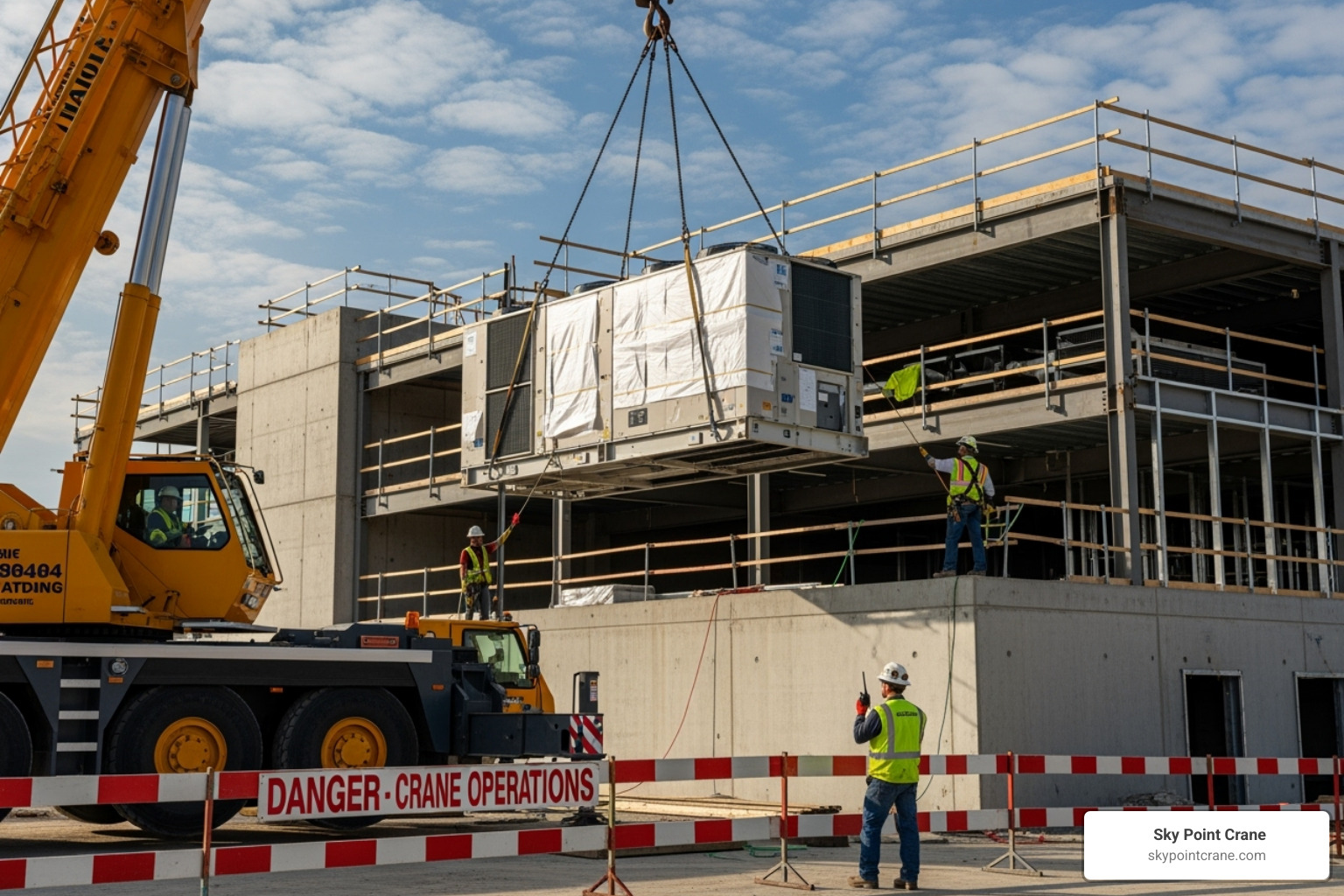Why Building Data Centers Is More Critical Than Ever
Building data centers is a complex and vital infrastructure project in our digital age. With data creation exploding and AI workloads surging, businesses need facilities that can handle massive computational demands while maintaining 99.999% uptime.
Key stages for building data centers successfully:
- Strategic Planning – Assess needs, select optimal sites with power access
- Design Phase – Plan power systems, cooling, and security infrastructure
- Construction – Execute building with specialized equipment and safety protocols
- Equipment Installation – Deploy servers, networking, and storage systems
- Testing & Commissioning – Verify all systems before going live
- Operations – Monitor efficiency and maintain business continuity
The stakes are high. A misstep in planning or construction can cost millions and jeopardize operations. Modern data centers can consume over 100 megawatts of power, making reliable electricity the foundation of any project.
Every project, from hyperscale to enterprise, demands specialized expertise, from foundation work to the precision lifting of massive cooling units and generators. The complexity includes regulatory compliance, disaster planning, and future-proofing.
I’m Dave Brocious. With over 30 years in project management and heavy equipment operations, I’ve gained deep insights into the challenges of building data centers. At Sky Point Crane, I’ve seen how proper planning and specialized lifting solutions are crucial for these mission-critical projects.

Stage 1: Strategic Planning and Site Selection
Building data centers starts with strategic planning. Getting this stage wrong makes everything that follows exponentially harder and more expensive. This is the foundation for your business continuity strategy.
Needs Assessment: Scale and Purpose
First, determine what the facility will do. The answer dictates everything from size to construction methods.
- Hyperscale facilities, built for giants like Amazon and Google, handle enormous computational loads and AI workloads. They are designed for massive scale, prioritizing power availability and advanced cooling.
- Enterprise data centers serve specific business needs, often on corporate campuses. They are typically smaller but still require robust, customized power, cooling, and security for requirements like HIPAA compliance.
- Hybrid cloud models add complexity, requiring on-premise data centers to integrate seamlessly with cloud services while maintaining control over sensitive data.
Budgeting and Cost Factors
Financial planning is critical. The physical building construction typically runs $300-$500 per square foot, but that’s just the start. IT equipment, power infrastructure, and cooling systems can easily triple that initial investment. Factors like local weather, structural needs, and materials also significantly impact the bottom line.
Site Selection: The Foundation of Success

Choosing the right location is paramount. As industry experience shows, site selection is the foundation for your business continuity strategy. Key factors include:
- Power availability: This is the single most critical factor. A large data center can consume 100+ megawatts of electricity. Regions like Northern Virginia are hotspots due to robust power grids and competitive energy prices. According to mapping the best data center locations in 2024, access to renewable energy is also increasingly important.
- Water access: Crucial for many cooling systems, especially in warmer climates. Inadequate water resources can drive up cooling costs.
- Fiber connectivity: Proximity to major fiber networks ensures low-latency connections and high data transmission rates.
- Risk and environment: A thorough assessment of natural disaster risks (floods, earthquakes, etc.) is necessary. Cooler climates can reduce energy consumption by allowing for “free cooling” methods.
- Community and regulations: Local support, favorable tax incentives, and a smooth regulatory environment are vital. Community opposition can halt projects, making stakeholder engagement crucial.
Regulatory and Compliance Standards
Building data centers involves navigating a complex maze of regulations. Failure to comply is expensive and can lead to shutdowns.
- GDPR applies to data from EU citizens, demanding strict privacy and security.
- HIPAA governs protected health information, requiring comprehensive security rules.
- FISMA applies to federal agencies and contractors, mandating extensive security programs.
- Other standards like PCI DSS (payment cards) and SOX (financial records) add more requirements.
Understanding these standards from the start is essential, as retrofitting for compliance is far more costly than building it right the first time.
Stage 2: The Core of Data Center Design
After planning and site selection, the design phase transforms plans into the detailed blueprints that guide construction. Decisions made here will impact the facility’s operations for decades.
Fundamental Components of a Data Center
Data center design involves two interconnected systems: the physical facility (the building, raised floors, fire suppression, security) and the IT infrastructure (servers, storage, networking equipment). These components must work in perfect harmony.
Physical Space Design
The physical layout must balance current needs with future growth while maximizing efficiency. This includes a scalable floor plan for easy navigation and equipment placement.

The hot aisle/cold aisle containment system is a key design element. Server racks are arranged so that equipment draws cool air from “cold aisles” and exhausts hot air into “hot aisles.” This prevents air from mixing and dramatically improves cooling efficiency. Small details like using blanking plates in empty rack spaces further optimize airflow. Accessibility for technicians and equipment, along with weight considerations for heavy server racks on raised floors, are also critical design factors.
Power System Design
Power is the lifeblood of a data center and its largest operational expense. The design must ensure adequate capacity and reliability. This involves calculating power demands and ensuring power quality to protect sensitive equipment.
Backup solutions are non-negotiable for achieving high uptime. A UPS system provides immediate power during an outage, allowing time for generators to start. For longer outages, redundant generators (e.g., one natural gas, one diesel) provide robust protection.
Cooling Systems
Managing the immense heat generated by IT equipment is a primary design challenge. Heat management involves calculating the required cooling capacity. Modern best practices show that running cold aisles at 78-80°F instead of the traditional 68-72°F can yield significant power savings.
Efficiency is measured by the PUE metric (Power Usage Effectiveness). A PUE below 2.0 is considered good. Following data center cooling best practices helps achieve low PUE ratings. Advanced strategies include free cooling with outside air and high-efficiency liquid cooling for dense environments.
Physical and Cybersecurity
Protecting the data center requires a layered approach. Physical security includes secure entrances, video surveillance, on-site personnel, and physical barriers. Cybersecurity involves firewalls, intrusion detection, encryption, and continuous monitoring to protect against digital threats.
Building Management System (BMS)
A BMS acts as the facility’s central nervous system, monitoring and managing HVAC, power, lighting, and security. How a BMS integrates with data center operations shows how it provides real-time data and automates responses to maintain optimal conditions.
Design Standards and Certifications
Adhering to recognized standards ensures reliability. The Uptime Institute Tier Standard defines four levels of redundancy, from basic Tier I to fault-tolerant Tier IV. Other key standards include ANSI/TIA 942-B, the EN 50600 series, ANSI/BICSI 002-2019, and ASHRAE guidelines. These standards are vital for guaranteeing adherence to an SLA and ensuring consistent performance.
Stage 3: The Blueprint for Building Data Centers
Now comes the exciting part—watching your carefully crafted design transform into a real, tangible facility. Building data centers moves from blueprints to bulldozers, and this construction phase demands precision, expertise, and careful coordination at every step.
Construction Phases and Project Management
Data center construction is like a complex orchestra where every contractor and delivery must be perfectly timed. The process moves from site preparation and foundation work to structural, mechanical, and electrical installations, culminating in system commissioning. Unlike a typical warehouse, every system must be flawless from day one.
Expert project management is invaluable for synchronizing contractors and maintaining quality standards. For the critical heavy lifting, our Crane Project Management services ensure every lift is planned with precision, coordinating timing, logistics, and safety.
Sustainable Construction Practices
Sustainability is now a core part of modern data center construction.
- Modular construction has revolutionized the process. Up to 80% of the infrastructure can be fabricated in controlled factory environments and installed quickly on-site. This reduces construction time, minimizes waste, and improves quality.
- Prefabrication works with modular methods, with components arriving ready for immediate installation.
- Green building practices include using energy-efficient technologies, innovative water management systems, and incorporating recycled materials like steel and concrete.
Heavy Equipment Logistics and Safety Protocols

Building data centers involves lifting monumentally heavy and expensive equipment. A UPS unit can weigh 50,000 pounds, and backup generators can exceed 100,000 pounds. This is where our expertise at Sky Point Crane is essential. Our Crane Use for Building Data Centers services use heavy-duty equipment for these challenging lifts. Our NCCCO certified operators understand that placing a massive HVAC unit requires millimeter-precise placement and absolute safety.
Safety protocols are critical. With zero margin for error, we follow stringent Crane Rental Company Safety Protocols: What to Look For Before Your Next Big Lift to protect crews, equipment, and everyone on site.
Key Construction Materials and Methods for Building Data Centers
Choosing the right materials is about long-term protection for critical infrastructure.
| Feature | Concrete | Steel |
|---|---|---|
| Advantages | Highly fire-resistant; withstands natural disasters better; good thermal mass for temperature stability. | Lighter and easier to transport; faster erection time; greater flexibility in design; fire protectant can be sprayed on surface. |
| Disadvantages | Heavier and slower to erect; less flexible for future modifications; higher transportation costs. | Less fire-resistant without additional treatment; can be more susceptible to corrosion if not properly coated. |
| Use Cases | Foundations, walls, floors, and hardened exteriors for disaster resistance (e.g., in tornado zones). | Structural framework, roofing, and internal supports. |
Tilt-up construction, where concrete panels are cast on the ground and tilted into place, is popular for its speed. Insulated panels provide excellent thermal insulation, improving energy efficiency. For roofing, durable and weather-resistant membranes like EPDM or metal systems are common choices.
Overcoming Challenges in Building Data Centers
Experienced builders anticipate and steer common obstacles.
- Scalability and flexibility: Plan for future growth by including extra space and capacity in the initial design. Adaptable infrastructure is key to accommodating future technologies.
- Resilience engineering: Build redundancy into all critical systems—power, cooling, and network connectivity—with backup equipment and robust failover mechanisms.
- Supply chain and permitting: Effective procurement planning is needed to manage long lead times for specialized equipment. Proactive engagement with local authorities can streamline the permitting process.
- Precision lifting solutions: Installing multi-million-dollar equipment in tight spaces requires more than just a large crane. Our 3D Lift Planning services simulate complex lifts in advance, ensuring precision, efficiency, and safety for challenging installations across Western and Central Pennsylvania, Ohio, West Virginia, and Maryland.
Stage 4: Equipping and Operationalizing Your Facility
With the physical structure complete, the next critical stage involves populating the data center with its essential IT infrastructure and preparing it for operation.
IT Equipment Procurement
Procuring the right IT equipment is crucial for performance and scalability. This involves selecting reliable vendors and products.
- Server Selection: Choose servers that meet current and future processing needs while considering energy efficiency and footprint.
- High-Capacity Storage: Implement robust storage solutions (HDDs, SSDs) to handle growing data volumes, including air-gapped backups for security.
- Networking Gear: Select high-performance switches, routers, and firewalls. Initiatives like the Open Compute Project (OCP) can offer flexible, cost-effective hardware designs.
Network Connectivity
A data center’s value depends on its network. This requires robust internal and external connections.
- Internal Connections: Efficient internal networking involves meticulous fiber optic cabling, rack setup, and cable management for optimal airflow and maintenance.
- External Connections: Plan for sufficient bandwidth and low-latency connections, often using multiple ISPs for redundancy.
- Impact of the 5G Network: The rise of 5G increases demands for data transmission rates and volume, requiring data centers to adapt their infrastructure accordingly.
Disaster Recovery and Business Continuity Planning
A comprehensive plan for unexpected events is essential. Disaster Recovery (DR) involves procedures to recover IT infrastructure and data after an incident, relying on regular backups and off-site replication. Business Continuity (BC) focuses on maintaining essential functions during a disruption through failover systems and redundant paths. A data center’s ability to guarantee adherence to an SLA depends on these plans.
Efficiency Measurement and Improvement
Continuous monitoring is key to managing and improving efficiency.
- Improving PUE: Operators constantly strive to lower the Power Usage Effectiveness (PUE) ratio by optimizing airflow and adjusting cooling set points.
- Continuous Monitoring: Data Center Infrastructure Management (DCIM) tools provide real-time oversight of power, temperature, and capacity, enabling proactive issue resolution.
Emerging Trends
The data center landscape is constantly evolving.
- Edge Computing: Smaller data centers located closer to data sources reduce latency for applications like IoT and autonomous vehicles.
- AI Workloads: The growth of AI and ML drives the need for compute-dense data centers with advanced cooling solutions like liquid cooling.
- Modular Data Centers: Prefabricated modules offer faster deployment and scalability.
- Sustainability Focus: There is a growing emphasis on minimizing water use, reducing e-waste, and sourcing renewable energy.
Frequently Asked Questions about Building a Data Center
How much does it cost to build a data center?
The cost varies significantly. The physical building construction is estimated at $300-$500 per square foot, but this excludes the most expensive components. The power and cooling infrastructure adds millions. The IT equipment itself—servers, storage, and networking gear—can easily double or triple the total investment. A large enterprise data center can cost hundreds of millions or even billions of dollars.
What is the most critical factor for data center site selection?
Without question, access to stable, high-capacity power is the most critical factor. A large data center can consume over 100 megawatts of power, enough for about 80,000 homes. Without a guaranteed, reliable power source, a project is not viable. Proximity to robust power grids, substations, and competitive energy rates is essential. While water access, fiber connectivity, and low disaster risk are important, power availability is the ultimate go/no-go factor.
What are data center tiers?
Data center tiers, defined by standards like the Uptime Institute Tier Standard and ANSI/TIA 942-B, classify facilities based on their reliability and redundancy.
- Tier I: The most basic level, with a single path for power and cooling and no backup systems.
- Tier II: Adds some redundant components (e.g., backup generators or chillers) but still relies on a single distribution path.
- Tier III: Features multiple paths for power and cooling, allowing for maintenance without shutting down operations (concurrently maintainable).
- Tier IV: The highest level, offering fault tolerance with multiple, independent, and active power and cooling paths. A single failure will not affect operations, achieving 99.995% uptime or higher.
Conclusion
Building data centers is a complex but rewarding challenge, changing empty land into the digital backbone of our world. Every stage, from site selection to commissioning, requires precision, expertise, and meticulous attention to detail.
The scope is staggering, involving facilities that consume immense power and require flawless operation 99.999% of the time. The process moves from careful strategic planning and intricate design to a construction phase with unique challenges, like lifting 50-ton generators and massive cooling units. Finally, equipment installation and commissioning bring the facility to life.
The future of data centers is evolving with edge computing, AI workloads, and a greater focus on sustainability. However, the fundamentals remain: reliable power, effective cooling, robust security, and meticulous planning. Success depends on partnerships with experienced architects, contractors, and specialized service providers.
At Sky Point Crane, we understand that the right lifting solutions can make or break these projects. Our NCCCO certified operators and comprehensive project management ensure that massive components are positioned safely and efficiently. From generators to cooling units that require millimeter precision, we understand the stakes.
For complex construction projects requiring expert lifting solutions in Western and Central Pennsylvania, Ohio, West Virginia, and Maryland, explore our comprehensive crane services. We’re here to help you lift your next big project to success—safely, efficiently, and with the expertise these critical facilities deserve.
